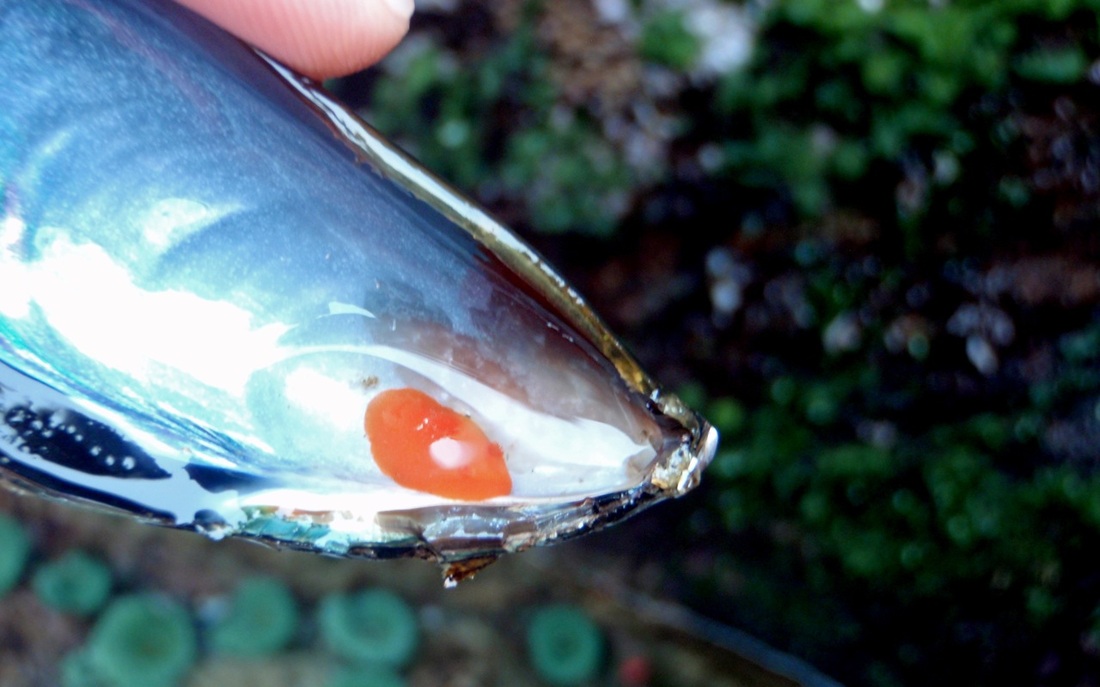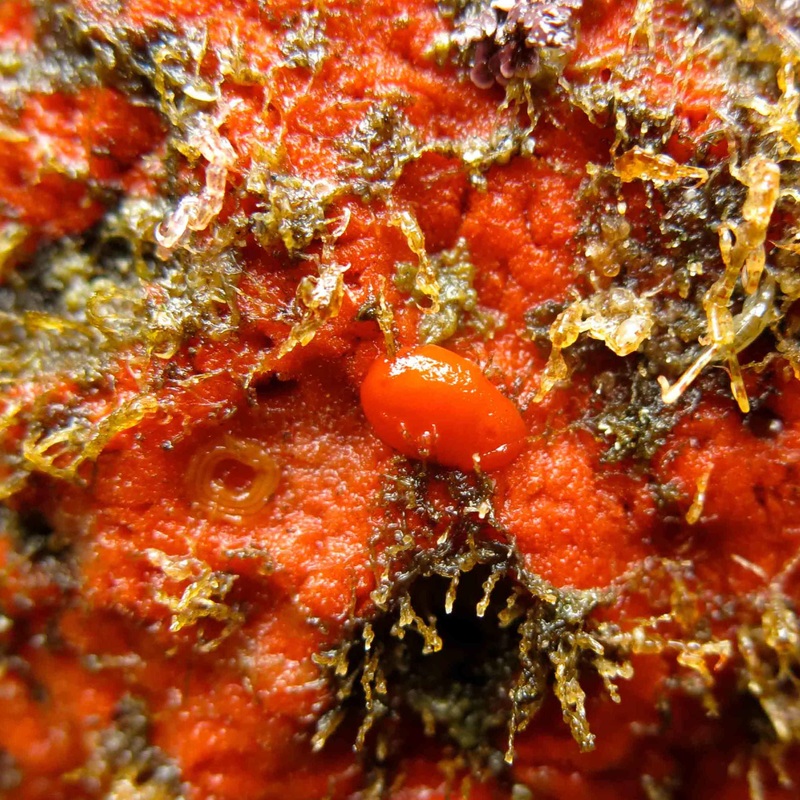Red sponge nudibranch • Rostanga pulchra
Left: a tiny red sponge nudibranch in a mussel shell. Photo by Amanda Cook. Right: a red sponge nudibranch with (and likely eating) a patch of red velvet sponge. Note the egg ribbon, laid in a spiral, to the left of the nudibranch. Photo by Jenn Burt.
Identification
The red sponge nudibranch is a dorid, meaning it is flattened and has a retractable gill plume. It is oval in shape and grows to only 1.5 cm long. It is solid red or orange, though its dorsal side may be sprinkled with tiny black or brown dots (not to be confused with the distinct line of dots on Cooper's dorid - see 'Similar Species' below). Its dorsal side bears small tubercles that give it a fuzzy appearance. When the gills and rhinophores are retracted it looks like an indistinct orange or red blob. It deposits similarly-coloured eggs in ring formations. Click here for more photos.
Habitat & Range
The red sponge nudibranch can be found on or around the encrusting red sponges which it preys upon, including the red velvet sponge (Clathria pennata). It lives in the intertidal and subtidal to a depth of 100 m.
Similar Species
Cooper's dorid (Aldisa cooperi) can be distinguished from the red sponge nudibranch by the small black speckles that line the mid-dorsal of Cooper's dorid. Cooper's dorid tends to be lighter in colour, varying from yellow to orange rather than orange to red.
The red sponge nudibranch is a dorid, meaning it is flattened and has a retractable gill plume. It is oval in shape and grows to only 1.5 cm long. It is solid red or orange, though its dorsal side may be sprinkled with tiny black or brown dots (not to be confused with the distinct line of dots on Cooper's dorid - see 'Similar Species' below). Its dorsal side bears small tubercles that give it a fuzzy appearance. When the gills and rhinophores are retracted it looks like an indistinct orange or red blob. It deposits similarly-coloured eggs in ring formations. Click here for more photos.
Habitat & Range
The red sponge nudibranch can be found on or around the encrusting red sponges which it preys upon, including the red velvet sponge (Clathria pennata). It lives in the intertidal and subtidal to a depth of 100 m.
Similar Species
Cooper's dorid (Aldisa cooperi) can be distinguished from the red sponge nudibranch by the small black speckles that line the mid-dorsal of Cooper's dorid. Cooper's dorid tends to be lighter in colour, varying from yellow to orange rather than orange to red.
References
Cowles, D. (2007). Rostanga pulchra MacFarland, 1905. Invertebrates of the Salish Sea. Rosario Beach Marine Laboratory. Accessed 24/07/2014.
Harbo, R. M. (1999). Whelks to whales: Coastal marine life of the Pacific Northwest. Madeira Park, BC: Harbour Publishing. P. 112.
Lamb, A., and Hanby, B. (2005). Marine Life of the Pacific Northwest [electronic resource]. Madeira Park, BC: Harbour Publishing.
Authors and editors of page
Kelly Fretwell and Brian Starzomski (2014).
Cowles, D. (2007). Rostanga pulchra MacFarland, 1905. Invertebrates of the Salish Sea. Rosario Beach Marine Laboratory. Accessed 24/07/2014.
Harbo, R. M. (1999). Whelks to whales: Coastal marine life of the Pacific Northwest. Madeira Park, BC: Harbour Publishing. P. 112.
Lamb, A., and Hanby, B. (2005). Marine Life of the Pacific Northwest [electronic resource]. Madeira Park, BC: Harbour Publishing.
Authors and editors of page
Kelly Fretwell and Brian Starzomski (2014).





